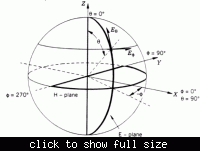ashish.mw
Full Member level 2
Dear all,
I am novice with HFSS. I have started working on antennas and have come across many terms like:
E-plane radiation pattern
H-plane radiation pattern
Elevation and radiation pattern
Cross and co polarization
I tried to follow Ludwig's work but surfing through the forums made my task a bit complex.
Now i wish to see each of the above curves via HFSS. Can anybody please take a bit of time to explain me the procedure of how to plot these curves. I shall be highly obliged. Please reply asap. Thanks in advance
I am novice with HFSS. I have started working on antennas and have come across many terms like:
E-plane radiation pattern
H-plane radiation pattern
Elevation and radiation pattern
Cross and co polarization
I tried to follow Ludwig's work but surfing through the forums made my task a bit complex.
Now i wish to see each of the above curves via HFSS. Can anybody please take a bit of time to explain me the procedure of how to plot these curves. I shall be highly obliged. Please reply asap. Thanks in advance
